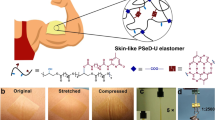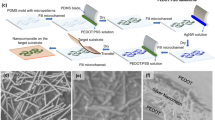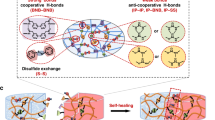Abstract
Pressure sensitivity and mechanical self-healing are two vital functions of the human skin. A flexible and electrically conducting material that can sense mechanical forces and yet be able to self-heal repeatably can be of use in emerging fields such as soft robotics and biomimetic prostheses, but combining all these properties together remains a challenging task. Here, we describe a composite material composed of a supramolecular organic polymer with embedded nickel nanostructured microparticles, which shows mechanical and electrical self-healing properties at ambient conditions. We also show that our material is pressure- and flexion-sensitive, and therefore suitable for electronic skin applications. The electrical conductivity can be tuned by varying the amount of nickel particles and can reach values as high as 40 S cm−1. On rupture, the initial conductivity is repeatably restored with ∼90% efficiency after 15 s healing time, and the mechanical properties are completely restored after ∼10 min. The composite resistance varies inversely with applied flexion and tactile forces. These results demonstrate that natural skin's repeatable self-healing capability can be mimicked in conductive and piezoresistive materials, thus potentially expanding the scope of applications of current electronic skin systems.
This is a preview of subscription content, access via your institution
Access options
Subscribe to this journal
Receive 12 print issues and online access
$259.00 per year
only $21.58 per issue
Buy this article
- Purchase on Springer Link
- Instant access to full article PDF
Prices may be subject to local taxes which are calculated during checkout




Similar content being viewed by others
References
Kim, D. H. et al. Epidermal electronics. Science 333, 838–843 (2011).
Mannsfeld, S. C. B. et al. Highly sensitive flexible pressure sensors with microstructured rubber dielectric layers. Nature Mater. 9, 859–864 (2010).
Takei, K. et al. Nanowire active-matrix circuitry for low-voltage macroscale artificial skin. Nature Mater. 9, 821–826 (2010).
Wagner, S. et al. Electronic skin: architecture and components. Physica E 25, 326–334 (2004).
Cotton, D., Graz, I. & Lacour, S. P. A multifunctional capacitive sensor for stretchable electronic skins. Sensors J. 9, 2008–2009 (2009).
Lipomi, D. J. et al. Skin-like pressure and strain sensors based on transparent elastic films of carbon nanotubes. Nature Nanotech. 6, 788–792 (2011).
Someya, T. et al. A large-area, flexible pressure sensor matrix with organic field-effect transistors for artificial skin applications. Proc. Natl Acad. Sci. USA 101, 9966–9970 (2004).
Ramuz, M., Tee, B. C.-K., Tok, J. B-H. & Bao, Z. Transparent, optical, pressure-sensitive artificial skin for large-area stretchable electronics. Adv. Mater. 24, 3223–3227 (2012).
Pang, C. et al. A flexible and highly sensitive strain-gauge sensor using reversible interlocking of nanofibres. Nature Mater. 11, 795–801 (2012).
Ilievski, F., Mazzeo, A., Shepherd, R., Chen, X. & Whitesides, G. M. Soft robotics for chemists. Angew. Chem. Int. Ed. 50, 1930–1935 (2011).
Shepherd, R. F. et al. Multigait soft robot. Proc. Natl Acad. Sci. USA 108, 20400–20403 (2011).
Chen, X. et al. A thermally re-mendable cross-linked polymeric material. Science 295, 1698–1701 (2002).
Burnworth, M. et al. Optically healable supramolecular polymers. Nature 472, 334–337 (2011).
Cordier, P., Tournilhac, F., Soulié-Ziakovic, C. & Leibler, L. Self-healing and thermoreversible rubber from supramolecular assembly. Nature 451, 977–980 (2008).
Montarnal, D., Tournilhac, F., Hidalgo, M., Couturier, J-L. & Leibler, L. Versatile one-pot synthesis of supramolecular plastics and self-healing rubbers. J. Am. Chem. Soc. 131, 7966–7967 (2009).
Yuan, W. et al. Fault-tolerant dielectric elastomer actuators using single-walled carbon nanotube electrodes. Adv. Mater. 20, 621–625 (2008).
Brochu, P. & Pei, Q. Advances in dielectric elastomers for actuators and artificial muscles. Macromol. Rapid Commun. 31, 10–36 (2010).
Nakahata, M., Takashima, Y., Yamaguchi, H. & Harada, A. Redox-responsive self-healing materials formed from host–guest polymers. Nature Commun. 2, 511–516 (2011).
Phadke, A. et al. Rapid self-healing hydrogels. Proc. Natl Acad. Sci. USA 109, 4383–4388 (2012).
Li, Y., Li, L. & Sun, J. Bioinspired self-healing superhydrophobic coatings. Angew. Chem. Int. Ed. 122, 6265–6269 (2010).
Wong, T-S. et al. Bioinspired self-repairing slippery surfaces with pressure-stable omniphobicity. Nature 477, 443–447 (2011).
Wang, Q. et al. High-water-content mouldable hydrogels by mixing clay and a dendritic molecular binder. Nature 463, 339–343 (2010).
Williams, K., Boydston, A. & Bielawski, C. Towards electrically conductive, self-healing materials. J. R. Soc. Interface 4, 359–362 (2007).
White, S. R. et al. Autonomic healing of polymer composites. Nature 409, 794–797 (2001).
Odom, S. A. et al. Restoration of conductivity with TTF-TCNQ charge-transfer salts. Adv. Funct. Mater. 20, 1721–1727 (2010).
Blaiszik, B. J. et al. Autonomic restoration of electrical conductivity. Adv. Mater. 24, 398–401 (2012).
Odom, S. A. et al. A self-healing conductive ink. Adv. Mater. 24, 2578–2581 (2012).
Blaiszik, B. J. et al. Self-healing polymers and composites. Annu. Rev. Mater. Res. 40, 179–211 (2010).
Li, Y., Chen, S., Wu, M. & Sun, J. Polyelectrolyte multilayers impart healability to highly electrically conductive films. Adv. Mater. 24, 4578–4582 (2012).
Ghosh, S. K. Self-Healing Materials: Fundamentals, Design Strategies, and Applications (Wiley, 2009).
Zhang, M. Q. & Rong, M. Z. Self-Healing Polymers and Polymer Composites (Wiley, 2011).
Wojtecki, R. J., Meador, M. A. & Rowan, S. J. Using the dynamic bond to access macroscopically responsive structurally dynamic polymers. Nature Mater. 10, 14–27 (2010).
Brunsveld, L., Folmer, B. J. B., Meijer, E. W. & Sijbesma, R. P. Supramolecular polymers. Chem. Rev. 101, 4071–4098 (2001).
Lehn, J-M. Supramolecular polymer chemistry—scope and perspectives. Polym. Int. 51, 825–839 (2002).
Wang, L. et al. A new approach for the fabrication of an alternating multilayer film of poly(4-vinylpyridine) and poly(acrylic acid) based on hydrogen bonding. Macromol. Rapid Commun. 18, 509–514 (1997).
Wool, R. Self-healing materials: a review. Soft Matter 4, 400–418 (2008).
Uchikoshi, T., Sakka, Y., Yoshitake, M. & Yoshihara, K. A study of the passivating oxide layer on fine nickel particles. Nanostruct. Mater. 4, 199–206 (1994).
Sekitani, T. et al. A rubberlike stretchable active matrix using elastic conductors. Science 321, 1468–1472 (2008).
Stauffer, D. & Aharony, A. Introduction to Percolation Theory (Taylor & Francis, 1994).
Nan, C. W., Shen, Y. & Ma, J. Physical properties of composites near percolation. Annu. Rev. Mater. Res. 40, 131–151 (2010).
Bloor, D., Graham, A., Williams, E. J., Laughlin, P. J. & Lussey, D. Metal–polymer composite with nanostructured filler particles and amplified physical properties. Appl. Phys. Lett. 88, 102103 (2006).
Wang, P. & Ding, T. Conductivity and piezoresistivity of conductive carbon black filled polymer composite. J. Appl. Polym. Sci. 116, 2035–2039 (2010).
Stoddart, J. F. Thither supramolecular chemistry? Nature Chem. 1, 14–15 (2009).
Carpi, F., Bauer, S. & De Rossi, D. Stretching dielectric elastomer performance. Science 330, 1759–1761 (2010).
Acknowledgements
The authors acknowledge funding support from the Air Force Office of Scientific Research (grant no. FA9550-12-1-01906). B.C-K.T. acknowledges support from the National Science Scholarship (NSS) from the Agency for Science, Technology and Research (A*STAR). R.A. acknowledges support from the Stanford Graduate Fellowship (SGF) and the Center for Advanced Molecular Photovoltaics (CAMP). Z.B. acknowledges support from LG Display. The authors thank D.J. Lipomi and J. Mei for fruitful discussions, and J.B-H. Tok, N. Liu and Y. Tan for proofreading the manuscript drafts. Thanks also go to I. Wong and Y. Ohkura for help with mechanical testing, and to Y. Diao for initial help with material characterization.
Author information
Authors and Affiliations
Contributions
B.C-K.T., C.W. and Z.B. conceived, designed and directed the project. B.C-K.T., C.W. and R.A. performed the experiments. C.W. synthesized and characterized the polymer materials. R.A. performed all the rheological measurements and analysis. B.C-K.T. and C.W. co-wrote the manuscript draft. All authors discussed the results and commented on the manuscript.
Corresponding author
Ethics declarations
Competing interests
The authors declare no competing financial interests.
Supplementary information
Supplementary information
Supplementary information (PDF 22249 kb)
Supplementary movie S1
Supplementary movie S1 (MOV 24442 kb)
Supplementary movie S2
Supplementary movie S2 (MOV 7814 kb)
Rights and permissions
About this article
Cite this article
Tee, BK., Wang, C., Allen, R. et al. An electrically and mechanically self-healing composite with pressure- and flexion-sensitive properties for electronic skin applications. Nature Nanotech 7, 825–832 (2012). https://doi.org/10.1038/nnano.2012.192
Received:
Accepted:
Published:
Issue Date:
DOI: https://doi.org/10.1038/nnano.2012.192
This article is cited by
-
Robot, repair thyself: laying the foundations for self-healing machines
Nature (2024)
-
Synthesis, Mechanism, and Applications of Self-healing Materials
Biomedical Materials & Devices (2024)
-
Localizing strain via micro-cage structure for stretchable pressure sensor arrays with ultralow spatial crosstalk
Nature Communications (2023)
-
A healable, mechanically robust and ultrastretchable ionic conductive elastomer for durably wearable sensor
Nano Research (2023)
-
Ultrasensitive wearable strain sensor for promising application in cardiac rehabilitation
Advanced Composites and Hybrid Materials (2023)



